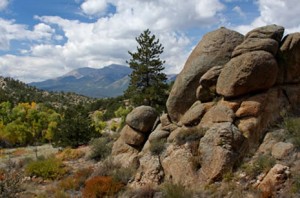Article by Marcia Darnell
Local Artists – November 1995 – Colorado Central Magazine
Crestone artist Maggie Houston-Smith says she creates out of a “sense of futility.Green Acres<170> reruns, drives her to paint and sculpt.
Her newest production is courtesy of Lexam Explorations. Four Raku masks, entitled “The Canary is Dead in the Mine,” reflect her horror at the advent of oil drilling near her home in the San Luis Valley.
Houston-Smith sees oil drilling as a ploy that may lead to another attempt at taking the water, and she worries about what the drilling might do to the aquifer below the valley.
But even with the drilling rigs at large, “We live in one of the last beautiful places on Earth,I’ve traveled enough to know that and we’re destroying it!<170> Too passionate to sit, she paces Gallery West in Alamosa, where some of her work is shown.
“I’m through being involved in the human race!”
What Houston-Smith calls her “futility fatiguefor a long time,<170> including stints in Yampa, Gunnison, and Moffat.
Her parents always encouraged her to create. “We were allowed to make messes,always had room for painting and sculpting.”
Her first protest work was generated about twenty years ago, when Amax proposed the Mount Emmons molybdenum mine near Crested Butte.
After Houston-Smith retired from teaching, she and her husband, a retired British warrant officer, moved to Belize, where her protest turned to outrage.
“The rivers and reef are used as dumps. Raw sewage flows past homes and people dump trash into the sea. The British army is there, by invitation, and the soldiers used to joke about discipline: If someone made trouble, he’d be tossed into the Belize River, where he would become infected by some deadly disease.”
After several years of world travel, Houston-Smith and her husband settled in Crestone. She’s determined to stay, “even if they cover the whole place with drilling rigs!”
In the gallery, she continues to pace, insisting she doesn’t believe in anything, yet making passionate declarations:
“People who are birthing children today must get out there and make a difference in what’s happening to our only home
“It’s important that each of us see what we can do to save our home.”
“The human race is determined to eat its own tail. What can be more insane than that?”
“If everyone were an artist
“The coupling of human overpopulation with the plunder by industry is not new in human history. In the 20th century, however, the capacity for this folly now goes forth with a ferocity and speed never before experienced on earth
Even her more contemplative pieces make a statement about human futility: starry skies dwarf man-made structures, which in turn tower over individuals. “She Left Hong Kong” reveals a woman whose life has been drastically changed by government decree.
Her work is on display at White Eagle Village in the Baca as well as Gallery West in Alamosa. Her paintings and sculptures, up until the Raku “Canary is Dead in the Mine” series, are celebrations of the beauty and wonder in the San Luis Valley that surrounds here.
As for her own creations, Houston-Smith says she’ll remain in Crestone and produce where her muse and her surroundings propel her.
“Where I am, that’s what I do.”
Marcia Darnell lives in the San Luis Valley, where artistic talent grows thicker than sagebrush.

